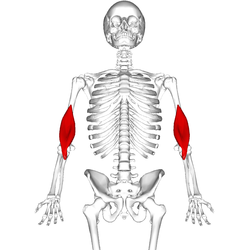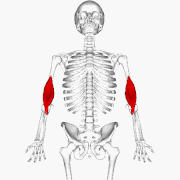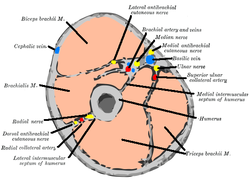| Brachialis | |
|---|---|
 Deep muscles of the chest and front of the arm, with the boundaries of the axilla. (Brachialis visible at bottom right.) Deep muscles of the chest and front of the arm, with the boundaries of the axilla. (Brachialis visible at bottom right.) | |
 Position of brachialis (shown in red). Position of brachialis (shown in red). | |
| Details | |
| Origin | Anterior surface of the humerus, particularly the distal half of this bone |
| Insertion | Coronoid process and the tuberosity of the ulna |
| Artery | Radial recurrent artery, brachial artery |
| Nerve | Musculocutaneous nerve (C5-C7) and radial nerve (C5, C6) |
| Actions | Flexion at elbow joint |
| Identifiers | |
| Latin | musculus brachialis |
| TA98 | A04.6.02.018 |
| TA2 | 2469 |
| FMA | 37667 |
| Anatomical terms of muscle[edit on Wikidata] | |
The brachialis (brachialis anticus) is a muscle in the upper arm that flexes the elbow. It lies beneath the biceps brachii, and makes up part of the floor of the region known as the cubital fossa (elbow pit). It originates from the anterior aspect of the distal humerus; it inserts onto the tuberosity of the ulna. It is innervated by the musculocutaneous nerve, and commonly also receives additional innervation from the radial nerve. The brachialis is the prime mover of elbow flexion generating about 50% more power than the biceps.
Structure
Origin
The brachialis originates from the anterior surface of the distal half of the humerus, near the insertion of the deltoid muscle, which it embraces by two angular processes. Its origin extends below to within 2.5 cm of the margin of the articular surface of the humerus at the elbow joint.
Insertion
Its fibers converge to a thick tendon which is inserted into the tuberosity of the ulna, and the rough depression on the anterior surface of the coronoid process of the ulna.
Innervation
The brachialis muscle is innervated by the musculocutaneous nerve, which runs on its superficial surface, between it and the biceps brachii. However, in 70-80% of people, the muscle has double innervation with the radial nerve (C5-T1). The divide between the two innervations is at the insertion of the deltoid.
Blood supply
The brachialis is supplied by muscular branches of the brachial artery and by the recurrent radial artery.
Variation
The muscle is occasionally doubled; additional muscle slips to the supinator, pronator teres, biceps brachii, lacertus fibrosus, or radius are more rarely found.
Function
The brachialis flexes the arm at the elbow joint. Unlike the biceps, the brachialis does not insert on the radius, and does not participate in pronation and supination of the forearm.
History
Etymology
The brachialis muscle In classical Latin bracchialis means of or belonging to the arm, and is derived from classical Latin bracchium, "arm". The expression musculus brachialis is used in the current official anatomic nomenco Terminologia Anatomica.
Additional images
-
 Position of brachialis (shown in red). Animation.
Position of brachialis (shown in red). Animation.
-
 Still image.
Still image.
-
 Horizontal section through the middle of upper arm. (Brachialis labeled at center left.)
Horizontal section through the middle of upper arm. (Brachialis labeled at center left.)
-
 Muscles of forearm, including insertion of brachialis tendon. Cross section. (Brachialis labeled at bottom left.)
Muscles of forearm, including insertion of brachialis tendon. Cross section. (Brachialis labeled at bottom left.)
-
 Left humerus. Anterior view.
Left humerus. Anterior view.
-
 Bones of left forearm. Anterior aspect.
Bones of left forearm. Anterior aspect.
-
 Nerves of the left upper extremity.
Nerves of the left upper extremity.
-
Brachialis muscle (labeled in green text)
See also
This article uses anatomical terminology.References
![]() This article incorporates text in the public domain from page 444 of the 20th edition of Gray's Anatomy (1918)
This article incorporates text in the public domain from page 444 of the 20th edition of Gray's Anatomy (1918)
- ^ Saladin, Kenneth S, Stephen J. Sullivan, and Christina A. Gan. Anatomy & Physiology: The Unity of Form and Function. 2015. Print.
- ^ Drake, Richard L.; Vogl, Wayne; Tibbitts, Adam W.M. Mitchell; illustrations by Richard; Richardson, Paul (2005). Gray's anatomy for students. Philadelphia: Elsevier/Churchill Livingstone. p. 662,672. ISBN 978-0-8089-2306-0.
- ^ "Brachialis Muscle." Kenhub. Kenhub, Aug. 2001
- "Human Osteology". ScienceDirect. Retrieved 2024-08-21.
- "Brachialis." UW Department of Radiology. University of Washington, Nov. 2005
- Di J.H. (Ed.) (1997).Stedman’s concise me10b">Triepel, H. (1910). Die anatomischen Namen. Ihre Ableitung und Aussprache. Mit eitte Auflage). Wiesbaden: Verlag J.F. Bergmann.
- ^ Lewis, C.T. & Short, C. (1879). A Latin dictionary founded on Andrews' edition of Freund's Latin dictionary. Oxford: Clarendon Press.
- Federative Committee on Anatomical Terminology (FCAT) (1998). Terminologia Anatomica. Stuttgart: Thieme
External links
- Illustration: brachialis from The Department of Radiology at the University of Washington
| Muscles of the arm | |||||||||||||||||
|---|---|---|---|---|---|---|---|---|---|---|---|---|---|---|---|---|---|
| Shoulder |
| ||||||||||||||||
| Arm (compartments) |
| ||||||||||||||||
| Forearm (compartments) |
| ||||||||||||||||
| Hand |
| ||||||||||||||||